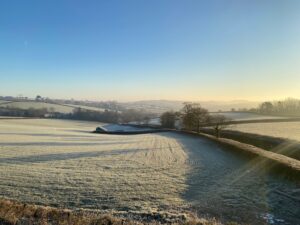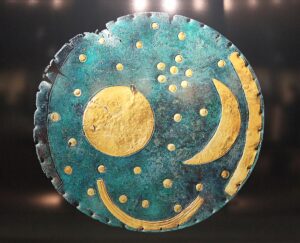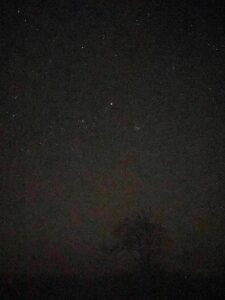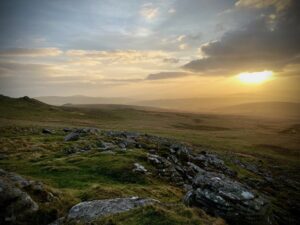What might we miss, ponders Elizabeth Wainwright, when we ignore the cycles and offerings of the ancient globe in favour of an endless line of progression?

I have been living inside lines.
Some lines are self- and other-imposed ‘shoulds’ which I am slowly learning to cast off. Other lines have been of division and tribes — loud but loveless, disappearing when I move close to them. Some lines appeared as scrawled ticks next to my name, scratched by people who were fed up with the status quo, enough ticks finally winning me a seat on my District Council in the local elections. Another line was more private, written by hormones on a pregnancy test stick but declared invalid months later by a miscarriage, a wild red vanishing that erased the linearity of plans as well as the lines of a tiled bathroom floor. There is a new line though, life trying to be born again. “May 4th, 2023” my midwife tells me. “That’s your due date. A spring baby, how nice, everything will be blossoming.” I think to myself how it is the same day as the local elections, the day that my four-year Council term will come to an end.
It will be a time for practical beginnings and endings: sterile council chambers swapped for the intimacy of a crib; stale language swapped for the wail of new life; opposition swapped for union. T.S.Eliot said, ‘What we call the beginning is often the end. And to make an end is to make a beginning. The end is where we start from.’ His words speak of continuity. But they also call to my mind linear progression, pieces of train track laid end to end, one thing leading predictably, efficiently to the next. And linear progression doesn’t seem to be working — in my life, in global economics and development, in knowing the purpose of any of it. There is no line to follow, there is no line that divides, there never was. Author Hermann Hesse said, ‘the rectilinear belongs only to Geometry and not to Nature and Life.’
But still, the dominant narrative of western history is of linear progress and growth, despite much of the earth being shaped by cycles. Cycles of menstruation, months, moons; cycles and stories of ancestors passed on; cycles of materials, seasons, life. What do we miss by seeing in an endless line of progression and growth, blind to the cycles and offerings of the ancient, rounded globe? I wonder whether May need not be a line that divides endings and beginnings for me, other than practically, and I find myself thinking back to the British Museum’s 2022 ‘World of Stonehenge’ exhibition.
The light changes when I enter. I perceive old and new things, and strange things enchant me — a headdress made of a deer skull and antlers, which was used to help a hunter become one with hunted; the remains of a meal shared between farmers and hunter-gatherers; a wooden sea henge pulled and preserved from the North Sea. But the thing that buries itself into the layers of me is the Nebra Sky Disc, a Bronze Age 30cm, 2kg circular map of the sky buried 3,600 years ago. Now, unearthed, the bronze disc has coloured to a green-blue patina. The sky disc is thought to be the world’s oldest map of the stars, and until its discovery buried in a hill in a forest in Germany, nobody thought prehistoric people capable of such exact astronomical knowledge. The disc was so accurate that it was used by Babylonian astronomers to calculate leap years. The sky disc was more than just a two-dimensional map though. It was a vision of the cosmos that held change as well as stability, being reimagined and layered over time to make room for new information and beliefs.

Frank Vincentz, CC BY-SA 4.0, via Wikimedia Commons
The disc’s life was made in phases: first, individual stars, the Pleiades star cluster, a crescent moon, and a sun were depicted in gold. Later, crafters added a solar boat to ferry the sun through the heavens, and later still an arc of gold at the edge spanning 82 degrees, the angle of the summer and winter solstices at the location it was used. The disc brought together symbols that depicted what people saw and what they believed.
I have a photo of the sky disc pinned by my desk, and I am coming to see other things layered between its beauty and history. I see connections over vast distances of space, land, time — the disc was found in present day Germany, but its gold has been traced to Cornwall and Romania. I see science alongside myth, belief and story given as much weight as reason; life not being divided up into categories. I see the incarnation of ancient things whose significance we will never know. I see a vision of the cosmos that invites participation and evolution. I see people guided by malleable questions and cycles more than certainty.
I worry that I am not finishing my Council term well. I worry that I do not finish a lot of things well — I start with energy, and work hard, then feel myself burn out like a shooting star. But the sky disc whispers, there are no neat endings and divisions in the Earth, they are an illusion. How do I live as if there are things truer than the neatness of conclusions, linear progress, and achievement? How do I find and offer stability alongside the honesty of questions and spiralling change?
On the sky disc, the gold boat ferries the sun on its diurnal cycle — underwater through the night, then transferred via a fish to a day boat that sails above the sky. It is reborn each day. The solar boat is not just depicted on the sky disc; it is an idea found in other cultures too — Scandinavian, Egyptian. The boat is between horizons on a heavenly ocean, and I too am between horizons — work, politics, motherhood, identity — that do not represent, to me, neat categories with endings and beginnings. Instead, they are edges of a vast connected landscape that invites me deeper into life.

The Pleiades disappear in April and reappear in October, marking the annual agricultural cycle. The best time to see the star cluster, outside of the ancient sky disc, is deep in the winter sky. These past dark months, I have looked skyward to the Pleiades for its story, for the old wisdom it oversaw and for the new wisdom it calls forth. The constellation will soon disappear, but in its wake comes hawthorn and blackthorn, wild garlic and bluebells, and my baby, whose due date was brought forward to the end of April. Life is bursting to declare itself, to weave itself into the turning year.
People ask why I will not continue in politics. Maybe because politics, like the sun on the sky disc, needs rebirth — I have tried to help midwife this locally, I have done what I can and I am tired. Maybe because I want to excavate layers of life rather than pursue well-trod paths or climb ladders. Maybe because I am actually an outsider, someone who is better at watching and seeing more than doing. Maybe that is just a cop-out. All I know is that I feel pulled to something deeper, truer, where no tracks and no ladders are needed, and the only lines are those of poetry and meaning, of learning and things passed on, of the porous and life-filled Devon hedgerows outside, of outstretched arms reaching for each other across false lines of division and certainty.
Like the sky disc, I am being reimagined and layered over time to make room for new life. Perhaps politics will be too, perhaps it will gather around new stories, and evolve to serve possibility, humanity, and the turning Earth rather than power, process, growth, and appearance. The disc, the sky, and each of us are gilded with light and bright with beauty. To see it, we might take our eyes off the track and look out into the cosmos we’re all part of — above, alongside, below. We might allow our certainty to take a step back, and make more room for encounters, enchantment, and stories that might first need excavating from soil and sky and each other, folding what we learn into new cycles and expressions of life, awake to the reality of wonder and unexpected revelation.

As the sky turns, as my boat moves between horizons, I will look at politics, and motherhood, and all the other expressions of life, and know that the blossoming of each depends on the blossoming of all — that each piece informs and guides the whole not linearly according to our plans, but in cycles of community, of curiosity, of life unfurling and learning itself. Maybe we need new ways to live this, new stories to show us how to tie it all together. I am seeking them. For now, I’ll hold the lines that have contained my life up to the sun until they are molten. Then, I will re-cast them according to what life in its fullness asks, and I will offer these new shapes to the ever-forming heaven and earth.
*
Elizabeth Wainwright is a writer, District Councillor, coach, and hillwalking guide, with a background in international development. Her work has been published in Resurgence & Ecologist, Plough Magazine, and elsewhere. She has an occasional Substack newsletter and a website here.